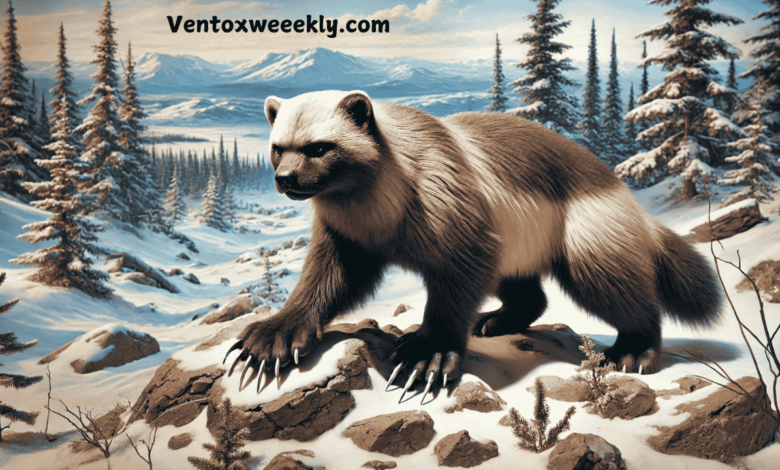The Fascinating World of Animal:lxjjx7snyfs= Wolverine: Nature’s Fierce and Resilient Predators

Wolverines are one of the most intriguing animals in the animal kingdom, known for their strength, resilience, and fierce nature. Despite their small size compared to other large predators, wolverines are formidable hunters and survivors. This comprehensive article will explore the world of wolverines, their habitat, behavior, diet, and the challenges they face today. This guide aims to give you an in-depth look at the animal:
- Lxjjx7snyfs= wolverine.
- Its importance in the ecosystem.
- Conservation efforts are needed to protect these remarkable creatures.
What is an Animal:lxjjx7snyfs= Wolverine?
The animal:lxjjx7snyfs= wolverine (Gulo gulo) is a muscular carnivorous mammal that belongs to the weasel family (Mustelidae). Despite its small stature, the wolverine is known for its strength, ferocity, and solitary nature. Often called the “glutton” due to its scientific name, wolverines are opportunistic feeders, and their diet varies depending on availability and season.
Habitat and Distribution
Wolverines are primarily found in the northern regions of North America, Europe, and Asia, thriving in cold environments such as boreal forests, tundras, and mountainous areas. They are well-adapted to the harsh climates of the Arctic and subarctic regions, where they hunt and scavenge across vast terrains.
Subheadings
North American Range
In North America, wolverines inhabit parts of Alaska, Canada, and some areas of the Rocky Mountains in the United States. Their range extends south of the Sierra Nevada and Cascade mountain ranges. The thick fur of the wolverine helps it survive the frigid temperatures of these regions.
Eurasian Range
Wolverines are found in countries like Norway, Sweden, Finland, Russia, Europe, and Asia. They also inhabit parts of the Siberian wilderness, thriving in isolated areas far from human settlements. These regions offer wolverines the solitude they need for hunting and raising their young.
Physical Characteristics
Wolverines have unique physical features that make them well-suited for survival in harsh environments.
Size and Appearance
Typically, wolverines weigh between 20 to 55 pounds (9 to 25 kg) and have a body length of about 26 to 34 inches (66 to 86 cm). Their fur is dense and dark, with lighter patches on their faces and sides, providing camouflage in snowy landscapes.
Paws and Claws
One of the most distinctive features of the wolverine is its powerful paws, which act like snowshoes, allowing it to traverse snowy terrains efficiently. Additionally, their sharp claws help them dig through the snow and hunt for prey hidden beneath it.
Scent Glands
Wolverines possess well-developed scent glands, which they use for marking their territory. They are territorial animals and often defend their hunting grounds fiercely. The scent marks serve as warnings to other wolverines and animals, asserting their dominance over the area.
Wolverine Behavior and Lifestyle
Wolverines are solitary animals and are most active during twilight hours. They patrol large territories constantly, covering up to 15 miles (24 km) daily for food. Let’s explore their behavioral patterns:
Hunting Techniques
Wolverines are opportunistic hunters and scavengers. Their diet includes small mammals like rabbits and rodents and larger animals such as deer or moose carcasses left by other predators. Their strong jaws and sharp teeth allow them to crush bones and feed on frozen remains during winter.
Reproduction and Life Cycle
Female wolverines give birth to one to five kits in late winter or early spring. These kits are born in dens built under deep snow or rocky crevices, offering protection from the cold and predators. Wolverines are protective parents; the young stay with their mother until they are two.
Social Interaction
Though primarily solitary, wolverines occasionally interact with other individuals during mating season or while sharing a large carcass. These interactions are often brief, as wolverines prefer to roam their territories alone, minimizing resource competition.
Diet and Feeding Habits
Wolverines have a diverse diet that varies depending on the season and availability of prey.
Carnivorous Diet
Wolverines are primarily carnivores, preying on small animals like rabbits, squirrels, and voles. They also hunt larger prey such as deer, mountain goats, and even weakened moose during the harsh winter months. Their ability to take down animals larger than themselves is a testament to their strength and skill as predators.
Scavenging
During winter, food can be scarce, and wolverines are known to scavenge on the remains left by other predators, such as wolves and bears. Their powerful sense of smell allows them to detect carcasses buried beneath deep snow, which they dig up with their sharp claws.
Plant Matter
While wolverines are mainly carnivorous, they occasionally consume plant matter, including berries and roots, especially during the summer when food is more abundant.
Threats and Conservation Efforts
Despite their resilience and adaptability, wolverines face several threats that endanger their survival.
Habitat Loss
Deforestation, mining, and human encroachment have significantly reduced the natural habitats of wolverines. As humans expand into remote areas, wolverines are forced to move further into isolated regions, limiting their range and access to food.
Climate Change
As temperatures rise due to climate change, wolverines face a shrinking habitat. Snow-covered areas, which they rely on for denning and hunting, are becoming less common, affecting their ability to reproduce and find food.
Hunting and Poaching
In some regions, wolverines are hunted for their fur, which is highly prized for warmth and durability. Illegal trapping and poaching have also contributed to declining population numbers.
Conservation Efforts
Conservationists and wildlife organizations are working tirelessly to protect wolverines and their habitats.
Protected Areas and Wildlife Corridors
Creating protected areas and wildlife corridors is crucial for wolverine conservation. By establishing safe zones, conservationists aim to provide wolverines with secure habitats where they can roam freely and hunt without the threat of human interference.
Monitoring and Research
Researchers use GPS tracking and monitoring programs to understand wolverine behavior, movement patterns, and population dynamics. These studies help identify critical habitats and develop effective conservation strategies.
Climate Action Initiatives
To mitigate the impact of climate change, efforts are underway to reduce carbon emissions and protect snow-covered regions vital for wolverine survival. By addressing the root causes of habitat loss, conservationists hope to create a sustainable future for wolverines and other Arctic animals.
Wolverines in Popular Culture
Wolverines have captured the imagination of people worldwide, inspiring stories and even superhero characters. Known for their toughness and resilience, wolverines have become symbols of strength and independence.
Wolverine Superhero
The iconic comic book character “Wolverine” from Marvel Comics draws inspiration from the animal’s ferocity and unyielding nature. The character embodies the strength and survival instincts characteristic of real-life wolverines.
Indigenous Folklore
In Indigenous cultures across North America, the wolverine is often featured as a cunning and resourceful animal in Folklore. Stories of its bravery and intelligence are passed down through generations, highlighting these communities’ respect and admiration for the creature.
Conclusion
Animal:lxjjx7snyfs= Wolverine are fascinating animals that play a crucial role in maintaining the balance of ecosystems across the Northern Hemisphere. Despite their small size, they possess immense strength, resilience, and adaptability. However, they face significant threats due to habitat loss, climate change, and hunting. By understanding and appreciating the world of wolverines, we can contribute to their conservation and ensure these incredible animals continue to thrive in the wild.
FAQs About Animal:lxjjx7snyfs= Wolverine
What is a wolverine?
A wolverine is a carnivorous mammal from the weasel family (Mustelidae). Known for its strength and resilience, it is often found in cold, remote regions such as the Arctic and subarctic areas of North America, Europe, and Asia.
Where do the Wolverines live?
Wolverines primarily inhabit cold regions, including the boreal forests, tundras, and mountainous areas of North America, such as Alaska, Canada, and parts of the Rocky Mountains, as well as regions in Scandinavia, Russia, and Siberia in Europe and Asia.
What do wolverines eat?
Wolverines are opportunistic carnivores that primarily eat small mammals like rabbits and rodents and larger prey like deer or moose carcasses. They also scavenge and eat plant matter, like berries, when other food is scarce.
Are wolverines dangerous to humans?
Wolverines are generally not dangerous to humans as they are solitary and avoid human contact. However, they can be aggressive when threatened, so it’s best to observe them from a distance if encountered in the wild.
How big are wolverines?
Wolverines typically weigh between 20 to 55 pounds (9 to 25 kg) and have a body length of about 26 to 34 inches (66 to 86 cm). Despite their small size, they are solid and capable of taking down larger prey.




